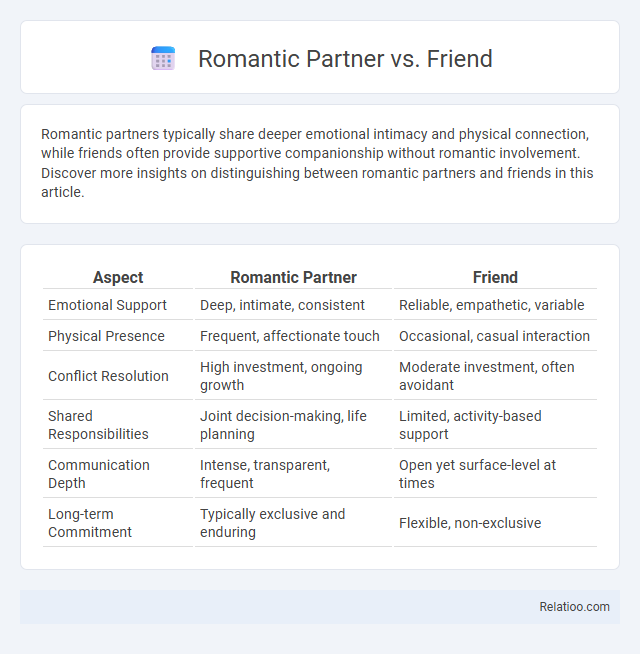Romantic partners typically share deeper emotional intimacy and physical connection, while friends often provide supportive companionship without romantic involvement. Discover more insights on distinguishing between romantic partners and friends in this article.
Table of Comparison
| Aspect | Romantic Partner | Friend |
|---|---|---|
| Emotional Support | Deep, intimate, consistent | Reliable, empathetic, variable |
| Physical Presence | Frequent, affectionate touch | Occasional, casual interaction |
| Conflict Resolution | High investment, ongoing growth | Moderate investment, often avoidant |
| Shared Responsibilities | Joint decision-making, life planning | Limited, activity-based support |
| Communication Depth | Intense, transparent, frequent | Open yet surface-level at times |
| Long-term Commitment | Typically exclusive and enduring | Flexible, non-exclusive |
Defining Romantic Partners and Friends
Romantic partners share an emotional and physical intimacy characterized by mutual attraction, exclusive commitment, and long-term relational goals, distinguishing them from friends who primarily offer emotional support and companionship without romantic or physical involvement. Friends contribute to your social well-being by providing trust, understanding, and shared interests, while romantic partners engage deeper levels of affection and interdependence. Understanding these distinctions helps define your expectations and boundaries within each relationship type.
Emotional Intimacy: Love vs. Friendship
Emotional intimacy with a romantic partner involves deep love, passion, and a strong physical and emotional connection that often includes vulnerability and commitment. Friendship intimacy centers on trust, support, and shared experiences, fostering affectionate bonds without romantic or sexual expectations. Your relationship's depth depends on how these emotional needs for love, companionship, and understanding are fulfilled in each context.
Communication Styles in Relationships
Romantic partners often engage in emotionally expressive and intimate communication, emphasizing vulnerability and affection to strengthen their bond. Friends typically use more casual, supportive, and reciprocal conversations aimed at shared experiences and mutual understanding. Partners in a collaborative sense, such as business or projects, prioritize clear, goal-oriented, and assertive communication to maintain efficiency and achieve common objectives.
Physical Affection: Boundaries and Expectations
Physical affection varies significantly across romantic partners, friends, and partners, with each relationship category having distinct boundaries and expectations. You may expect a romantic partner to engage in more intimate gestures such as hugging, kissing, and close physical proximity, while friendships typically involve lighter, more casual touch like pats on the back or brief hugs. Understanding these nuances helps maintain respect and clear communication, ensuring comfort and consent within each relationship type.
Support Systems: Partner or Friend?
Romantic partners typically provide dual emotional and practical support by fostering intimacy and shared life goals, while friends offer more flexible, less obligated support rooted in mutual interests and history. Studies show that support from romantic partners often correlates with higher relationship satisfaction and better stress management, whereas friendships contribute significantly to social well-being and resilience. Choosing between romantic partner or friend as a primary support system depends on the context of needs, emotional closeness, and reliability of each relationship.
Conflict Resolution: Comparing Dynamics
Romantic partners often engage in emotionally charged conflict resolution, relying heavily on communication patterns that balance passion and intimacy, whereas friendships emphasize mutual respect and understanding with less emotional intensity. Partners in business or collaborations typically focus on pragmatic problem-solving strategies aimed at achieving common goals and maintaining professional boundaries. Understanding these distinct dynamics enhances tailored approaches to conflict resolution based on relational context and emotional investment.
Shared Activities and Interests
Romantic partners often engage in shared activities that strengthen emotional intimacy and physical connection, such as date nights, travel, or cohabiting hobbies like cooking or fitness. Friends typically bond over common interests and casual activities, like sports, gaming, or social gatherings, fostering companionship without romantic expectations. Partners in business or projects prioritize collaborative tasks and goal-oriented activities that enhance teamwork and productivity while maintaining a professional relationship.
Long-Term Commitment: Differences and Similarities
Long-term commitment in a romantic partner typically involves emotional intimacy, shared goals, and often legal or social recognition, while friendship centers on mutual support and trust without romantic or physical expectations. A partner, in broader terms, can encompass both romantic and business relationships, emphasizing collaboration and shared responsibilities. Your understanding of these roles influences how you navigate expectations and build enduring connections across different types of relationships.
Social Perceptions of Relationships
Social perceptions of relationships vary significantly between romantic partners, friends, and partners in non-romantic contexts, influencing expectations and emotional support frameworks. Romantic partners are often viewed through lenses of intimacy, exclusivity, and long-term commitment, whereas friends are associated with trust, companionship, and emotional sharing without romantic obligations. Partners in professional or collaborative contexts emphasize cooperation, mutual goals, and boundary-setting, reflecting differing societal norms and roles assigned to each relational category.
Transitioning from Friendship to Romance
Transitioning from friendship to romance involves redefining boundaries and deepening emotional intimacy beyond traditional platonic support. Successful shifts rely on clear communication, mutual attraction, and a willingness to navigate vulnerabilities that may challenge the original dynamic. Research highlights that couples beginning as friends often experience stronger relationship satisfaction and longevity due to established trust and shared experiences.

Infographic: Romantic Partner vs Friend
 relatioo.com
relatioo.com